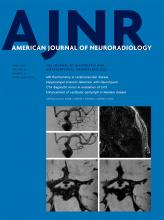Abstract
BACKGROUND AND PURPOSE: The increased severity of white matter disease is associated with worse outcomes and an increased rate of intracerebral hemorrhage in patients with ischemic stroke undergoing thrombolytic treatment. However, whether white matter disease is associated with outcomes in patients undergoing endovascular treatment remains unclear.
MATERIALS AND METHODS: In this prespecified exploratory analysis of our prospective multi-institutional study that enrolled consecutive adult patients with anterior circulation ischemic stroke undergoing endovascular treatment from November 2017 to September 2018, we compared the following outcomes between patients with none-to-minimal (van Swieten score, 0–2) and moderate-to-severe (van Swieten score, 3–4) white matter disease using logistic regression: 90-day mRS 3–6, death, intracerebral hemorrhage, successful recanalization, and early neurologic recovery.
RESULTS: Of the 485 patients enrolled in the Blood Pressure after Endovascular Stroke Therapy (BEST) study, 389 had white matter disease graded (50% women; median age, 68 years; range, 58–79 years). A van Swieten score of 3–4 (n = 74/389, 19%) was associated with a higher rate of 90-day mRS of 3–6 (45% versus 18%; adjusted OR, 2.73; 95% CI, 1.34–5.93; P = .008). Although the death rate was higher in patients with van Swieten scores of 3–4 (26% versus 15%), the adjusted likelihood was not significantly different (adjusted OR, 1.14; 95% CI, 0.56–2.26; P = .710). Ordered regression revealed a shift toward worse mRS scores with increasing van Swieten scores (adjusted common OR, 3.04; 95% CI, 1.93–4.84; P < .001). No associations between white matter disease severity and intracerebral hemorrhage, successful recanalization, and early neurologic recovery were observed.
CONCLUSIONS: Moderate-to-severe white matter disease is associated with worse outcomes in patients undergoing endovascular treatment without a significant increase in hemorrhagic complications. Studies comparing patients with and without endovascular treatment are necessary to determine whether the benefit of endovascular treatment is attenuated with greater white matter disease.
ABBREVIATIONS:
- aOR
- adjusted OR
- EVT
- endovascular treatment
- ICH
- intracerebral hemorrhage
- VSS
- van Swieten score
- WMD
- white matter disease
- © 2020 by American Journal of Neuroradiology
Indicates open access to non-subscribers at www.ajnr.org











